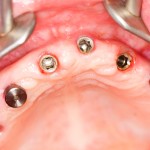
While the use of dental implants has become more routine there is still discussion around the most appropriate time for loading implants. The aim of this review was to compare annual failure rates and marginal bone level changes of implants loaded within 24 hours compared with conventional loading.
Searches were conducted in Medline and the Cochrane Central Register of Controlled Trials (CENTRAL). Only English language randomised controlled trials (RCTs) with more that 20 patients comparing immediate loaded implants (≤ 24hrs) with implants loaded after ≥ 3 months and followed up for more than 1 years were considered. Two reviewers independently undertook study selection and data abstraction. Quality was assessed using the Cochrane risk of bias tool.
- 10 RCTs (661 patients; 925 implants) were included
- 3 were considered to be at low risk of bias, 4 unclear and 3 at high risk.
- Follow up periods ranged from 12-60 months.
- Annual failure rates were 2.3% and 3.4% for conventionally and immediately loaded implants, respectively, a risk ratio of 0.82 (95% CI: 0.35–1.94, P > 0.05)
- For bone level changes the weighted mean difference (WMD) between immediate and conventional loading was:-
- 0.02 mm at 1 year (P > 0.05),
- 0.08 mm at 2 years (P > 0.05),
- -0.10 mm at 3 years (P > 0.05) and
- -0.3 mm at 5 years (P < 0.05).
- The total WMD for the combined follow-up was 0.01 mm (P > 0.05).
The authors concluded
the number of studies regarding RCTs reporting at least 1-year outcome data on loading within 24 h after implant placement as compared to CL is limited and that no clinically relevant difference regarding AFRs as well as radiographic bone-level changes between conventionally and immediately loaded implants can be found, for up to 5 years of follow-up.
Comments
The search was restricted to English language studies so it is possible that some additional studies are available. The annual failure rates noted above have been calculated based on the assumption that 50% of those lost to follow up were actually lost. Based on the available data the annual failure rates were 1.6% and 3.3% for conventionally and immediately loaded implants, respectively. In their discussion the authors recommend interpreting the results of this review with caution owing to the limited number of studies, which is sensible. The 2013 update of the Cochrane review by Esposito et al (Dental Elf 10th April 2013) which looked at different loading times found:-
no convincing evidence of a clinically important difference in prosthesis failure, implant failure, or bone loss associated with different loading times of implants. The quality of the evidence is assessed as very low due to high and unclear risk of bias of primary studies and there is some evidence of reporting bias so clinicians should treat these findings with caution.
Links
Engelhardt S, Papacosta P, Rathe F, Ozen J, Jansen JA, Junker R. Annual failure rates and marginal bone-level changes of immediate compared to conventional loading of dental implants. A systematic review of the literature and meta-analysis. Clin Oral Implants Res. 2014 Mar 15. doi: 10.1111/clr.12363. [Epub ahead of print] PubMed PMID: 24628882.
Esposito M, Grusovin MG, Maghaireh H, Worthington HV. Interventions for replacing missing teeth: different times for loading dental implants. Cochrane Database of Systematic Reviews 2013, Issue 3. Art. No.: CD003878. DOI: 10.1002/14651858.CD003878.pub5.
